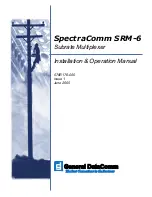
8588A/8558A
Remote Programmer's Manual
10
Each keyword in a SCPI command header represents a node in the SCPI
command tree. The leftmost keyword (CALCulate in the example above) is the
root-level keyword, representing the highest hierarchical level in the command
tree. The keywords following represent subnodes under the root node.
Command Trees like this one are used to document the SCPI command set in
this manual. The keyword CALCulate is the name of the CALCulate subsystem
and is on the root level of the CALCulate command tree.
AVERage and is the second-level node in the CALCulate subsystem, COUNt
and STATe are the lowest nodes or end nodes in the hierarchical tree. <
nrf
>
and
<boolean>
in the example tree are parameters to the end node.
Each colon in the command header moves the current path down one level from
the root in the command tree. Once you reach the leaf node level in the tree, you
can add several leaf node commands without having to repeat the path from the
root level as long as you comply with these simple rules:
•
The header path of the new leaf-node is the same as that of the previous
one. If not, the full header path must be given starting with a colon.
•
Additional commands are concatenated using a semi-colon (;)
•
The first command in a new program message must start from the root.
Using the tree example in Figure 2, both COUNt and STATe could be set with:
:CALCulate:AVERage:COUNT 32;:STATe ON (note the semi-colon).
As a DMM is primarily a sensor, the root mnemonic CALCulate is optional. SCPI
represents this optionality thus:
[:CALCulate]:AVERage:COUNT 32;STATe ON (note the semi-colon).
The square brackets indicate that exactly the same behaviour will result from:
:AVERage:COUNT 32;STATe ON (note the semi-colon).
This is the same as the two lines:
:AVERage:COUNT 32
:AVERage:STATe ON















































